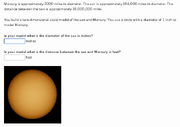Interpreting scale drawings is an exercise that appears under the 7th grade (U.S.) Math Mission. This exercise emphasizes connections between ratio and geometry.
Types of Problems[]
There are four types of problems in this exercise:
- Answer the questions based on scale: This problem describes a scaled situation and asks several problems based on the scale. The user is asked to find the answers and write them in the space provided.

Answer the questions based on scale
- Answer the model question: This problem provides a scale model problem and asks the user to answer a single question regarding a particular dimension.

Answer the model question
- Answer the question and interpret: This problem provides a scaled situation. The user is asked to find the solution to a problem and also to interpret the numbers in context.

Answer the question and interpret
- Use the model: This problem provides a model or scaled diagram. The user is asked to use the model to answer a related question.

Use the model
Strategies[]
Knowledge of scaling and ratios helps on this exercise as well as the relationship between similar objects as related to area and volume in addition to the standard lengths.
- If lengths (or the scale) is in ratio , then areas are in ratio and volumes are in ratio .
- Some unit conversion is necessary on a few problems.
Real-life Applications[]
- Architects use lots of geometry when building bridges, roofs on houses, and other structures.
- The ancient Egyptians from over 4000 years ago were very good at shapes and geometry. Every time the Nile burst its banks and flooded the planes, they had to use geometry to measure their gardens and fields all over again.




